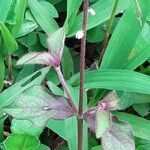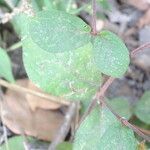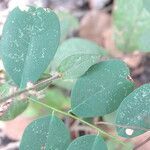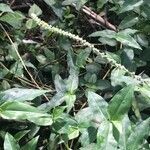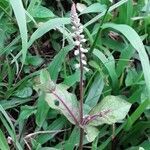Perennial herb, ascending or erect from a rooting base, 30-50 cm high; stem obtusely quadrangular, thickened above the nodes, often tinged with red, rather densely clothed with fine hairs. Leaves rhomboid-obovate or rhomboid-oblong from a contracted or narrowed, rounded, obtuse or acute base and a mostly triangular, acute or rather obtuse apex, entire, ciliate, bordered with red, otherwise green or, especially in a young state, more or less tinged with red, herbaceous, on both surfaces more or less densely patently hairy, 1¼-15 by ¾-6½ cm; petiole 1-12 mm. Flowers racemed; racemes terminal and often also in the highest leaf-axils, erect, straight or ± sinuous, 19-45 cm (including 1-12 cm peduncle); rachis rather densely pubescent; bracts ovate, acuminate very acute, reflexed after anthesis; clusters shortly stalked, in the lower part of the inflorescence more or less distant, in the higher part crowded, at first erect, afterwards patent, at last reflexed; lower clusters composed of 2-3 perfect ☿ flowers and several imperfect sterile ones; imperfect flowers towards the apex of inflorescence gradually fewer; apex of inflorescence bearing solitary perfect flowers without imperfect ones; stalks of clusters joined just above the base; ripe clusters falling off as a whole. Tepals of ☿ ovate-oblong, strongly mucronate, 2¼-3 mm long, dull pale green, glabrous within, externally clothed with appressed or patent, rather long, white hairs; outer ones 5-, inner ones 3-4 nerved. Free parts of the filaments ± 1 mm; anthers minute; pseudo-staminodes rectangular-cuneate with a truncate, shortly dentate apex. Ovary with a broad, flat top; style ± ⅔ mm. Utricle glabrous ± 1½ mm; seed shining brown. Imperfect flowers 1¾-2½ mm long, sessile or almost so; hooks obliquely patent, above the hairy base glabrous and usually red.
Erect or decumbent geniculate pubescent perennials to 1 m. high, often rooting at the lower nodes. Leaves strigose on both surfaces, entire or undulate, ovate to obovate, apically acute, basally acute to rounded, 2-6 cm. long, 1-4 cm. broad; petioles 2-8 mm. long. Inflorescences of terminal and axillary spikes of glomerules, the mature glomerule usually consisting of a central terminal perfect flower and 2 lateral perfect flowers, each of the lateral flowers subtended on each side by a cluster of about 20 hooks representing 3 modified flowers, the hooks not conspicu-ously longer than the glomerule, the 4'~ t peduncle of the glomerule articulated near the pubescent primary rhachis; spikes 5-30 cm. long, 4-7 mm. broad, with only the distal half continuous. Unmodified flowers perfect; bracts and bracteoles 2 subequal, ovate, mucronate or aristate, 1-1.5 mm. long; sepals 5, subequal, ovate, concave, scariose, pubescent throughout their length, with 1-3 ribs strongly ex-serted dorsally, 2-3 mm. long; stamens 5, 1-2 mm. long, united below to form a tube bearing 5 intercalated 3-dentate pseudostaminodia; ovary at first tympani-form, becoming ovoid; style 1, stigma 1, at anthesis about equaling the stamens. Utricle ovoid, inconspicuously operculate, 1-2 mm. long; seeds cochleate-orbiculate, succineous, smooth 1-1.5 mm. long.
Herbs perennial, 30-50 cm tall. Roots slender. Stem ascending or erect, tinged red, obtusely quadrangular, branched, inflated at nodes. Petiole 1-7 mm, long hairy; leaf blade ovate-rhombic or rhombic-oblong, 1.5-6 × 0.6-3 cm, both surfaces densely hairy and ciliate, base rounded, apex obtuse, narrowed from middle. Racemes terminal, erect and straight, with 2 or 3 hermaphroditic and some unisexual flowers, unisexual flowers gradually decreasing upward, with only 1 perfect flower at apex; rachis densely pubescent; flower clusters shortly stalked. Bracts reflexed after anthesis, 1-2 mm, apex acuminate. Tepals of perfect flowers light green, ovate-oblong, 2-3 mm, abaxially villous, adaxially glabrous, apex acuminate, with a mucro. Stamens 5; filaments 1-2 mm, united part only ca. 1 mm; pseudostaminodes rectangular, apex truncate. Tepals of imperfect flowers and bracts yellow, ca. 1.5 mm, base villous, apex hooked. Utricles globose, ca. 0.5 mm in diam., glabrous. Seeds brown, shiny, ovoid-oblong, very small, smooth. Fl. and fr. Jun-Nov.
Prostrate, weedy herb to 1 m, branched from base; stem striate, stoloniferous, rooting at lower nodes, thickened at nodes, reddish or purplish. Petiole 3-18 mm long; blade elliptical to rhombic or obovate-rhombic, 2-8.5 x 2.5-4 cm, obtuse, narrowed to base and apex, strigose. Inflorescence 0-to 2-branched from base, spiciform, pubescent, axis long, narrow, erect, glomerules distant towards middle and base of axis, to congested near apex; glomerules broadly ovoid or globoid, 1.5-3 mm long, rounded at apex, soon deflexed, usually comprising 2 fertile, 1 sterile and 4 rudimentary, uncinate flowers. Bisexual flowers 2-3 per cluster; tepals scarious, oblong-lanceolate, 1.6-2.4 mm long, mucronate, 3-veined, pubescent. Rudimentary flowers unisexual, greenish-white, about as long as bisexual flowers, reduced to 4-10 uncinate glochidia of ca. 1-1.5 mm long, scarcely longer than fruiting perianth; staminodes 3-or 4-fid Seed ovoid, smooth, shining, pale brown.
Herb, slender, to 0.5 m tall. Leaves: petiole 1–8 mm long; lamina rhombic to elliptic, rarely broadly obovate, (5–) 8–44 (54) mm long, (3–) 5–22 (–30) mm wide; base cuneate, acute. Inflorescence (20–) 35–190 mm long; peduncle (8–) 20–40 (–60) mm long; bracts broadly elliptical to ovate, 1.0–1.6 mm long, with a few hairs on outer base and edges; bracteoles ovate to broadly ovate, 1.1–1.8 (–2.1) mm long, with hair denser than on bracts. Inflorescence a cyme, subsessile; pedicel (0.3–) 0.5–1.0 mm long; single fertile flower subtended by 2 sterile flowers each with 12–34 spines (0.8–) 1.5–2.3 mm long. Tepals ovate, narrowly elliptic to ovate, (2.0–) 2.4–3.2 mm long, acute, covered externally with hairs. Stamens: filaments 1.1–1.5 mm long; pseudostaminodes rectangular, 0.25–0.3 mm long and wide, with apex often dentate. Style 0.5–0.8 mm long. Immature fruit ellipsoid, (1.2–) 1.4–2.0 mm long; immature seed ellipsoid, 1.25–1.6 mm long.
Spikes terminal on the stem and branches, at first dense, soon considerably elongating to as much as 25 cm. but mostly c. 6–15 cm. with maturing lower flowers increasingly distant, 5–7 mm. wide, peduncle up to c. 10 cm. long, axis and peduncle thinly to more or less densely pilose;bracts and bracteoles membranous, lanceolate-ovate, c. 1.5–2 mm. long, mucronate with the shortly excurrent midrib, glabrous or ciliate; flowers in sessile or shortly pedunculate clusters (peduncles to c. 2 mm. long), cymose, of 2–3 hermaphrodite flowers, the two laterals subtended by two modified flowers, or the uppermost hermaphrodite flowers of the spike solitary, similarly subtended by modified flowers, bibracteolate.
Leaves 1.5–8 × 1–5 cm., mostly rhomboid to rhomboid-ovate, sometimes rhomboid-elliptic to shortly oval or subcircular, occasionally with the margin outline distinctly excavate below and/or above the middle, shortly acuminate at the apex, acute to rather blunt (more rarely rounded), shortly cuneate to cuneate-attenuate at the base, subglabrous to moderately pilose with strigose hairs on both surfaces, subsessile or distinctly (up to 13 mm. long) petiolate.
Annual herb (? sometimes short-lived perennial), stems prostrate and rooting at the lower nodes to erect, 0.2–1.2 m., simple or usually branched up to about the middle, more or less swollen at the nodes, lower branches divaricate, the upper more erect; stem and branches bluntly 4-angled to subterete, striate or sulcate, subglabrous to more or less densely pilose (especially the lower internodes).
Tepals 2.25–3 mm. long, elliptic-oblong, 3-nerved, subglabrous to more or less densely white-pilose; the outer firmer with the lateral nerves more distinct and joining the shortly excurrent midrib just below the apex, usually more densely white-pilose than the inner; the inner sometimes more or less falcate, slightly shorter.
Spines of modified flowers sharply uncinate, numerous, glabrous, reddish, c. 2 mm., fasciculate, in fruit scarcely exceeding the tepals of the fertile flower; 2-or 3-flowered clusters, more or less globose finally deflexed, falling as a unit to form a “burr” c. 5 mm in diam.
Filaments very slender, c. 1.5 mm. long, the pseudostaminodes rectangular-cuneate with a truncate, dentate or excavate apex.
Capsule ovoid, membranous save for the flat, firm apex, c. 1.5 mm. long.
Style slender, c. 0.6 mm. long, often slightly swollen towards the base.
Seed ovoid, c. 1.5 mm. long, shining, brown, smooth.
More or less erect, much-branched weed, 1–3 ft. high
Leaves green, sometimes tinged with red
Ovary with a pileiform cap.
Flowers green, often galled
